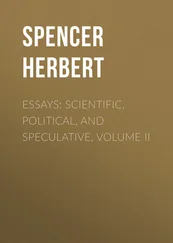Note III. Are the internal structures of celestial bodies all the same, or do they differ? And if they differ, can we, from the process of nebular condensation, infer the conditions under which they assume one or other character? In the foregoing essay as originally published, these questions were discussed; and though the conclusions reached cannot be sustained in the form given to them, they foreshadow conclusions which may, perhaps, be sustained. Referring to the conceivable causes of unlike specific gravities in the members of the solar system, it was said that these might be—
"1. Differences between the kinds of matter or matters composing them. 2. Differences between the quantities of matter; for, other things equal, the mutual gravitation of atoms will make a large mass denser than a small one. 3. Differences between the structures: the masses being either solid or liquid throughout, or having central cavities filled with elastic aëriform substance. Of these three conceivable causes, that commonly assigned is the first, more or less modified by the second."
Written as this was before spectrum-analysis had made its disclosures, no notice could of course be taken of the way in which these conflict with the first of the foregoing suppositions; but after pointing out other objections to it the argument continued thus:—
"However, spite of these difficulties, the current hypothesis is, that the Sun and planets, inclusive of the Earth, are either solid or liquid, or have solid crusts with liquid nuclei." [23]
After saying that the familiarity of this hypothesis must not delude us into uncritical acceptance of it, but that if any other hypothesis is physically possible it may reasonably be entertained, it was argued that by tracing out the process of condensation in a nebulous spheroid, we are led to infer the eventual formation of a molten shell with a nucleus consisting of gaseous matter at high tension. The paragraph which then follows runs thus:—
"But what," it may be asked, "will become of this gaseous nucleus when exposed to the enormous gravitative pressure of a shell some thousands of miles thick? How can aeriform matter withstand such a pressure?" Very readily. It has been proved that, even when the heat generated by compression is allowed to escape, some gases remain uncondensible by any force we can produce. An unsuccessful attempt lately made in Vienna to liquify oxygen, clearly shows this enormous resistance. The steel piston employed was literally shortened by the pressure used; and yet the gas remained unliquified! If, then, the expansive force is thus immense when the heat evolved is dissipated, what must it be when that heat is in great measure detained, as in the case we are considering? Indeed the experiences of M. Cagniard de Latour have shown that gases may, under pressure, acquire the density of liquids while retaining the aeriform state, provided the temperature continues extremely high. In such a case, every addition to the heat is an addition to the repulsive power of the atoms: the increased pressure itself generates an increased ability to resist; and this remains true to whatever extent the compression is carried. Indeed it is a corollary from the persistence of force that if, under increasing pressure, a gas retains all the heat evolved, its resisting force is absolutely unlimited . Hence the internal planetary structure we have described is as physically stable a one as that commonly assumed."
Had this paragraph, and the subsequent paragraphs, been written five years later, when Prof. Andrews had published an account of his researches, the propositions they contain, while rendered more specific and at the same time more defensible, would perhaps have been freed from the erroneous implication that the internal structure indicated is an universal one. Let us, while guided by Prof. Andrews' results, consider what would probably be the successive changes in a condensing nebulous spheroid.
Prof. Andrews has shown that for each kind of gaseous matter there is a temperature above which no amount of pressure can cause liquefaction. The remark, made a priori in the above extract, "that if, under increasing pressure, a gas retains all the heat evolved, its resisting force is absolutely unlimited ", harmonizes with the inductively-reached result that if the temperature is not lowered to its "critical point" a gas does not liquify, however great the force applied. At the same time Prof. Andrews' experiments imply that, supposing the temperature to be lowered to the point at which liquefaction becomes possible, then liquefaction will take place where there is first reached the required pressure. What are the corollaries in relation to concentrating nebulous spheroids?
Assume a spheroid of such size as will form one of the inferior planets, and consisting externally of a voluminous, cloudy atmosphere composed of the less condensible elements, and internally of metallic gases: such internal gases being kept by convection-currents at temperatures not very widely differing. And assume that continuous radiation has brought the internal mass of metallic gases down to the critical point of the most condensible. May we not say that there is a size of the spheroid such that the pressure will not be great enough to produce liquefaction at any other place than the centre? or, in other words, that in the process of decreasing temperature and increasing pressure, the centre will be the place at which the combined conditions of pressure and temperature will be first reached? If so, liquefaction, commencing at the centre, will spread thence to the periphery; and, in virtue of the law that solids have higher melting points under pressure than when free, it may be that solidification will similarly, at a later stage, begin at the centre and progress outwards: eventually producing, in that case, a state such as Sir William Thomson alleges exists in the Earth. But now suppose that instead of such a spheroid, we assume one of, say, twenty or thirty times the mass; what will then happen? Notwithstanding convection-currents, the temperature at the centre must always be higher than elsewhere; and in the process of cooling the "critical point" of temperature will sooner be reached in the outer parts. Though the requisite pressure will not exist near the surface, there is evidently, in a large spheroid, a depth below the surface at which the pressure will be great enough, if the temperature is sufficiently low. Hence it is inferable that somewhere between centre and surface in the supposed larger spheroid, there will arise that state described by Prof. Andrews, in which "flickering striæ" of liquid float in gaseous matter of equal density. And it may be inferred that gradually, as the process goes on, these striæ will become more abundant while the gaseous interspaces diminish; until, eventually, the liquid becomes continuous. Thus there will result a molten shell containing a gaseous nucleus equally dense with itself at their surface of contact and more dense at the centre—a molten shell which will slowly thicken by additions to both exterior and interior.
That a solid crust will eventually form on this molten shell may be reasonably concluded. To the demurrer that solidification cannot commence at the surface, because the solids formed would sink, there are two replies. The first is that various metals expand while solidifying, and therefore would float. The second is that since the envelope of the supposed spheroid would consist of the gases and non-metallic elements, compounds of these with the metals and with one another would continually accumulate on the molten shell; and the crust, consisting of oxides, chlorides, sulphurets, and the rest, having much less specific gravity than the molten shell, would be readily supported by it.
Clearly a planet thus constituted would be in an unstable state. Always it would remain liable to a catastrophe resulting from change in its gaseous nucleus. If, under some condition of pressure and temperature eventually reached, the components of this suddenly entered into one of those proto-chemical combinations forming a new element, there might result an explosion capable of shattering the entire planet, and propelling its fragments in all directions with high velocities. If the hypothetical planet between Jupiter and Mars was intermediate in size as in position, it would apparently fulfil the conditions under which such a catastrophe might occur.
Читать дальше












